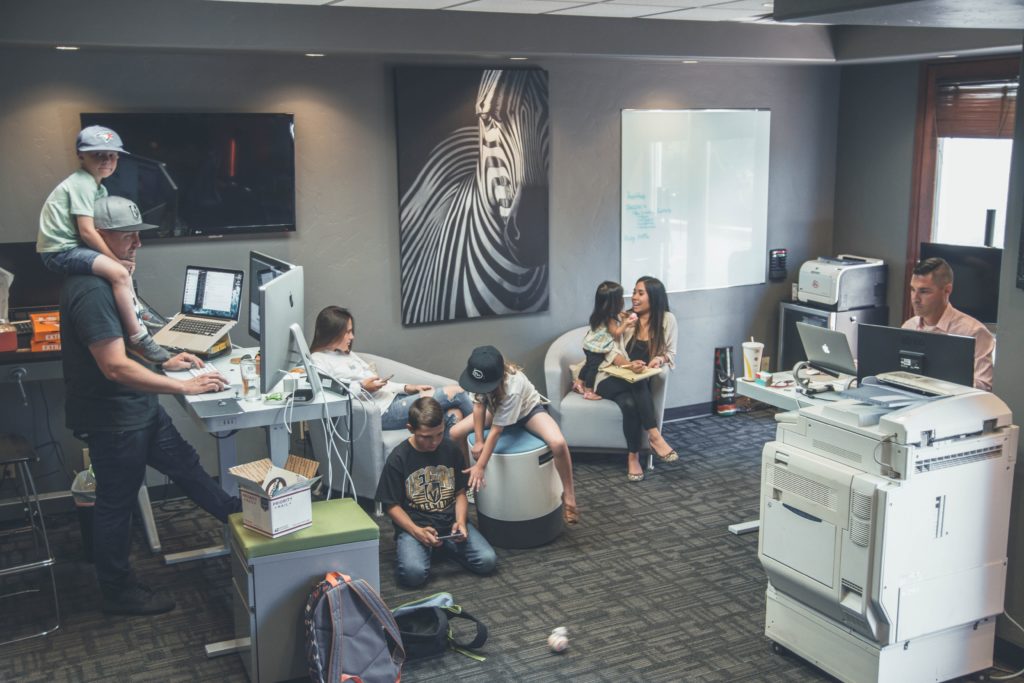…Because isolation + children + work = a brand-new problem.
The coronavirus outbreak means many of us will be working from home – a lot of us for the first time. Some of us even have the added complication of school closures. The combination of isolation, work, and dependants is undoubtedly a heady mix and an experience we are all probably feeling unequipped for.
However, there is some comfort to be had in that the impact of the coronavirus does not discriminate. From CEOs to managers, admin staff to field workers, this exile from ‘normal’ life affects everyone, and each one of us is having to find a way of dealing with this new reality. While the imposed isolation is temporary, no one knows how long it will go on for. It’s now a priority to work out a way of making our domestic and professional lives work together as successfully as possible.
“There is some comfort to be had in that the impact of the coronavirus does not discriminate. From CEOs to managers, admin staff to field workers, this exile from ‘normal’ life affects everyone.”
With this in mind, we have compiled tips and suggestions from successful home workers to help us through the next few weeks and months. We know that the impact of managers on workplace productivity and engagement is significant, so taking time to support staff right now is critical.
1. Prepare a workspace

A lot of us are about to find out that the sofa is not the best workstation. Balancing your laptop on your knees in bed or on the couch is a practical, physical, and psychological no-no. A few hours of doing this and you’ll soon realize why the average office has desks and chairs for their workers.
When working from home, it is vital to create an environment that is as separate from homelife as possible. Maintaining a separation from work and non-work – even if it’s just a different part of the room – allows you to have clear boundaries and helps productivity during the working day and will enable you to switch it off at the close of business.
Employee collaboration in the digital workplace
2. Make a plan
Many of us create a to-do list every morning in the office. This is just as important when working from home. Make a plan of what you’d like to get done that day: this creates order and allows you to form your day. Prioritize and leave some flex for unforeseen queries and contact from customers or colleagues, as well as for breaks. It may help your colleagues if you block time on your calendar so they can check when you’ll be free.
Try and make your to-do list a daily habit. Making a list helps to quell anxiety about the chaos of life, giving us a structure, a plan that we can stick to, and they are proof of what we have achieved that day, week, or month.
3. Take breaks

Offices offer a high level of sociability. Greeting people in the morning, catching up on the game from the weekend, stand up meetings, sharing stories from home: there is a lot of interaction throughout the day. When you work from home, you immediately notice this. And while it’s very easy to slip into a “head down, work-work-work mode” when not at the office, this can lead to fatigue.
Just like you would in the office, make sure you schedule breaks throughout the day. Even if it’s only a few minutes to get a drink or stretch your legs, and of course, make time for your lunch break away from your screen and phone.
Getting outside at least once a day is helpful; however, depending on the latest guidance (e.g. if everyone is quarantined), this might not be possible.
4. Be flexible
Being flexible is essential. You don’t have to check emails on your phone the minute you open your eyes or when you are on evening downtime with your family/partner/friends or self. If something urgent comes up, flexibility on hours is appreciated just as it is when working from the office. And in some cases, you’ll need this flexibility to balance your home life.
5. Dress code
While there is no need to carry on with smart business dress, it’s a good idea not to stay in your pajamas. While you may not be leaving the house, or being customer-facing, what you wear is psychologically very important. By following your regular pre-work routine – coffee, shower, dress – you’re gearing your mind and body into the right mindset. However, it’s possible you may not leave the house, so wear what is comfortable for you, but is also going to look acceptable on a video call to your colleagues, boss, and customers.
“By following your regular pre-work routine – coffee, shower, dress – you’re gearing your mind and body into the right mindset.”
6. Minimize distractions when necessary

There will be some moments within your working day that will require total silence. A customer call, or a video meeting with your team. In these instances, it’s a good idea to unplug your doorbell, put your phone on silent, put the dogs in another room in order to give your full attention. For those with children, this might be an excellent opportunity for some screen time! Remember the many alerts on your computer too – hit the ‘Do Not Disturb’ feature on your devices and shut down Outlook. This muting helps you fully focus for the duration (and there’s no barking, bing-bonging, or other interruptions while in the meeting). Don’t forget to turn these settings back when you’re done.
With that said, the reality is that with these unusual circumstances, many of us will be working with kids, partners, pets, and so on in the same household, so some noise in the background may not be so unusual any longer. Your colleagues will be a lot more understanding during this period – and will more than likely be tackling the same problems.
Employee collaboration in the digital workplace
7. Optimize your tools
There will be a lot of reliance on communication through your computer, whether it’s through Microsoft Teams, Zoom, Slack, Skype, or other services. Which is why one of the most important things to make sure you have is good audio. It is recommended to test your setup daily to ensure it works well. Video is also a valuable tool but requires more bandwidth, so check your wifi levels to make sure it’s strong enough. It has been estimated that 80% of communication is non-verbal. In a period of time such as this, where we will not be able to have those valuable face-to-face conversations, video can be a really important tool. And when we can see each other’s faces, it also helps reduce people talking over each other.
8. Stay connected

The key to staying motivated and productive when not in the office is to be connected. We have a wealth of tools available to us that makes it easy to be virtually present. Those of us who are working full time remotely, by geographic necessity or job role, make it work for the long term by being proactive in connecting with our colleagues regularly. This could be informally checking in via Teams, scheduling a “coffee chat”, or requesting a check-in with your manager or colleagues, if there’s nothing planned.
The key to staying motivated and productive when not in the office is to be connected.
While it may seem odd to create these virtual catch-ups, think about how many times your day in the office is punctuated by people grabbing you for a chat, looking at a project on someone’s computer, checking in on you. It’s important to recreate a similar kind of sociability even when we are working in our homes.
9. Customize your WFH Experience
In this enforced isolation, some roles will struggle with working from home more than others. Every role is different and will require some special adjusting. This is best done by communicating with your direct manager about your specific needs. Don’t be afraid to ask for support from your manager or even your peers who may be experiencing the same changes you are. Open discussion is key to making this work for your own unique situation.
And for home workers with children…

It may feel like two worlds colliding, but working from home with children can work – we just need to alter the way we work. Gone are the days where you remain undisturbed for hours. Now, you are juggling the welfare of your children, their education and happiness, and your job. While this can be overwhelming, we share some tips on how to muddle along and be a parent and co-worker at the same time.
10. Set a schedule

Children thrive on routine, and as much as it’s tempting to rely on screens, these should be used when you need it – ie, when you go on a meeting or as a reward at the end of the day. Make sure you have a schedule of things to do before break, before lunch, and after lunch. Don’t panic if this isn’t strictly adhered to; the plan should just act as a framework to keep on track. Ensure you have a good supply of school resources to hand and try and fit two core subjects into each day. Even if it’s for half an hour at a time. In fact, education experts recommend a short, sharp dose of learning over a prolonged period. A twenty-minute session of focusing on a worksheet or topic is proven to be more beneficial than spending all afternoon learning.
11. Think outside the box
Children do a lot of their learning from play. Building with LEGO teaches engineering skills, shooting hoops in the garden helps hand-eye coordination, working with playdough helps with motor skills and encourages creativity. Your children don’t need the rigidity of a regular school day.
“Through play, children are developing a range of skills which creates an excellent foundation for their development.”
Practice playful learning and know that whether it’s a jigsaw or a sandpit, children are developing a range of skills which creates an excellent foundation for their development. So, don’t feel guilty when they spend time playing during the day – they are being entertained and are learning at the same time.
12. Outside, if possible

While it is getting trickier to get out, kids need to burn off energy throughout the day. If it’s safe, use your break times to get the kids outside for a runaround. This, of course, covers the physical education side of their learning and can be a great opportunity to do fun things, like obstacle courses, races, and competitions. And of course, it’s also a way of exercise for yourself – which can boost endorphins, increase focus, and improve mental health.
13. Learn to work flexibly
While it might not be possible in all roles, working flexibly will help us over this period. Getting up early, and maybe catching up in the evenings will help us to cover our work responsibilities, as well as ensure our children are looked after. Our bosses know that normal working is not entirely feasible in this situation, and that saying no to an employee’s request for flexibility may backfire. It is important that you talk to your line manager about what works for you and your situation. While being out of our usual routine is daunting, many workers extol the virtues of flexible working – particularly regarding the afternoon lull and those hours that we’re less inclined to give 100%. It has been calculated that the prime slump time in business is around 2 pm. This might be the best time for us to step away from our computers and focus our attention on family life, to catch up on work later.
14. Go online
Many of your children’s lessons use online resources, so don’t be put off by going on the internet to aid homeschooling. There are some incredibly engaging websites designed to educate children. Sites like TedEd align with the curriculum to deliver well-produced pieces for kids to watch. Many other sites like ClassDojo and Times Table Rockstars use gamification to teach children maths and other subjects. There are now even courses on financial literacy, such as how to use a kids debit card, which can help make screen time more educational.
15. Look at the silver lining

The impact of coronavirus has forced us all to stay home and work remotely. This can induce stress, panic, and anxiety. But it is important to realize the benefits. For one, there is no commute, and all that extra time can be used to do something beneficial. Maybe fit in some additional exercise, take time out with the family, learn something new. It may feel intimidating now, but a change can quickly feel like the new norm, and as mentioned earlier, everyone is learning to adapt. Take comfort in knowing your team is learning to flex a new muscle by working in new ways.



